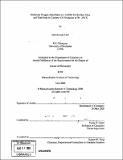Molecular oxygen adsorbates at a Au/Ni(111) surface alloy and their role in catalytic CO oxidation at 70 - 250 K
Author(s)
Lahr, David Louis
DownloadFull printable version (10.78Mb)
Other Contributors
Massachusetts Institute of Technology. Dept. of Chemistry.
Advisor
Sylvia T. Ceyer.
Terms of use
Metadata
Show full item recordAbstract
Oxygen is observed to adsorb molecularly on 0.13 - 0.27 ML Au/Ni(1 111) surface alloys at 77 K, in stark contrast to dissociative adsorption on Ni and no adsorption on Au surfaces. Molecular 02 adsorbates on the Au/Ni(111) surface alloy are identified by their 0=0 vibrational modes at 790, 850 and 950 cm-', measured by electron energy loss spectroscopy. Possible Ni adsorption sites for the three types of molecularly adsorbed 02 are proposed. The dramatic change in Ni reactivity occurs within a narrow Au coverage range around 0.13 ML Au and arises from poorer overlap between the Ni d-band and the 02 LUMO as the Ni d-band shifts to lower energy with increasing Au content of the Au/Ni surface alloy. The amount of molecular adsorption as a function of Au coverage cannot be described by an analytical or simulated model based on Au atom proximity to Ni sites, suggesting the role of cooperative effects in 02 stabilization. Adsorbed molecular 02 dissociates between 110 to 150 K. No oxygen desorbs. At Au coverages greater than 0.27 ML, the energy of the Ni d-band is shifted sufficiently low to destabilize oxygen adsorption. (cont.) Carbon monoxide is catalytically oxidized on the Au/Ni(111) surface alloy at 70 and 77 K via a Langmuir-Hinshelwood mechanism. Molecularly adsorbed 02 is identified as the reactant with adsorbed CO. The reaction probability at 77 K is 0.4. Atomically adsorbed O and CO do not react at 77 or 300 K. Between 108 and 125 K, CO reacts with either atomic O adsorbed on Au atoms or with molecularly adsorbed 02. Between 125-150 K, CO2 production coincides with 02 dissociation, suggesting a "hot atom" mechanism. The reactive potential energy surfaces likely have a late transition state. This work demonstrates that the nanoscale size of Au clusters and its associated quantum size effect are not the necessary feature that enables Au-catalyzed low temperature CO oxidation. Rather, this work strongly suggests that an adsorbed 02 species similarly stabilized at the perimeter of Au nanoparticles is the critical reactant in supported oxide systems.
Description
Thesis (Ph. D.)--Massachusetts Institute of Technology, Dept. of Chemistry, 2006. Includes bibliographical references.
Date issued
2006Department
Massachusetts Institute of Technology. Department of ChemistryPublisher
Massachusetts Institute of Technology
Keywords
Chemistry.